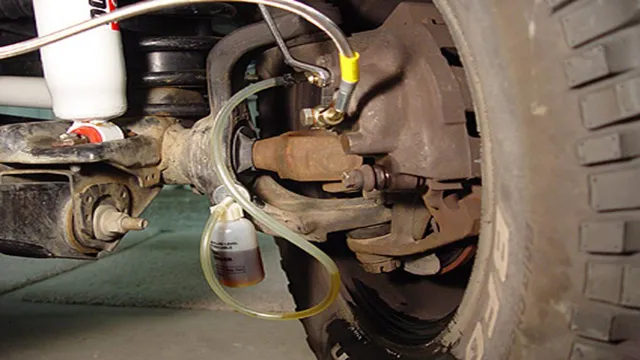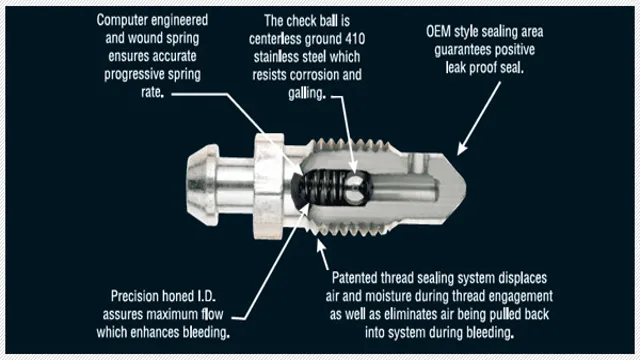Have you ever noticed the small screws attached to the calipers of your vehicle? These little devices are called brake bleeder screws, and they play a critical role in ensuring your brakes work correctly. Brake bleeder screws can be easily overlooked, yet they hold significant importance in the brake system’s overall function. Understanding how to use them properly can make a significant difference in your vehicle’s braking performance.
So, let’s dive into the world of brake bleeder screws, how they work, and what you should be aware of when using them.
What is a brake bleeder screw?
Brake bleeder screws are an essential component in a vehicle’s braking system. But what exactly are they and how do they work? Simply put, a brake bleeder screw is a small valve located at the top of each brake caliper. It allows for the release of air and any other unwanted fluids from the brake lines, which can cause brake failure if they are allowed to remain.
To use a brake bleeder screw, a mechanic or DIY enthusiast uses a specialized tool to open the valve and allow fluid to flow out while keeping an eye on the brake fluid reservoir to ensure it doesn’t run dry. By doing this, any air or unwanted fluid is removed from the braking system, ensuring high-quality performance and safety on the road. Overall, brake bleeder screws are crucial to keeping your brakes working as they should.
Basic function and purpose
A brake bleeder screw is a critical component of any hydraulic braking system. Its primary function is to release trapped air from the brake lines, which can cause reduced brake performance. The screw is located near the wheels and is fitted onto the brake caliper or wheel cylinder.
When the brakes are used, hydraulic fluid is forced into the brake lines, which can create air pockets due to the fluid’s low viscosity. These pockets of air can cause the brake pedal to feel spongy, reducing the effectiveness of the brakes. By opening the brake bleeder screw, the air is allowed to escape, enabling the system to function optimally.
Regular maintenance of the brake bleeder screw is essential to ensure that the brakes are working correctly. It’s always advisable to have the brake system checked by a professional mechanic to ensure that it is working optimally. Ultimately, keeping your brake bleeder screw clean and functional is essential for your safety on the road.

Types of brake bleeder screws
A brake bleeder screw is a small valve located at the top of the brake caliper or wheel cylinder that is used to release excess air from the brake system. Brake bleeder screws come in various types, each serving a specific purpose. The most common types of brake bleeder screws are brass and stainless steel, both of which have their advantages and disadvantages.
Brass bleeder screws are cheaper and easier to find, but they are also more prone to rust and corrosion. On the other hand, stainless steel bleeder screws are more durable and resistant to corrosion, but they are also more expensive. Additionally, some brake bleeder screws come with a check valve, which prevents air from entering the brake system.
It’s important to remember that using the wrong type of bleeder screw or not properly tightening the screw can lead to brake failure, so it’s crucial to follow the manufacturer’s recommendations when replacing or repairing brake components.
How do brake bleeder screws work?
Brake bleeder screws play a crucial role in maintaining the braking mechanism in our vehicles. So, how do brake bleeder screws work? Well, these screws help in removing the air bubbles that get trapped in the brake lines. When we press the brake pedal, the brake fluid flows through the brake lines and applies pressure on the brake pads or shoes, which in turn, stop the vehicle.
However, air bubbles can get trapped in the brake lines, which can reduce the performance of the brakes. This is where the brake bleeder screws come in. These screws are located at the highest point in the brake lines and can be opened to release any trapped air.
When we open the bleeder screw, the brake fluid and air escape through the screw, and we can see the bubbles coming out. By keeping the bleeder screw open until no more bubbles are visible, we can ensure that there is no air left in the brake lines, and the brakes will perform at their best. So, the simple yet efficient mechanics of the brake bleeder screw helps to keep us safe on the road.
Step-by-step process of using a brake bleeder screw
Brake bleeder screws are an essential component of any vehicle’s braking system and are typically found on the calipers or wheel cylinders. They allow air and old brake fluid to escape, making way for fresh brake fluid to reach the system. The process of using a brake bleeder screw involves connecting a hose to the screw and opening it while pushing the brake pedal.
This creates pressure in the system, forcing out the air and old fluid as new brake fluid flows in. It’s important to make sure the brake fluid reservoir is properly topped off during this process to prevent air from entering the system. By using a brake bleeder screw, you can keep your braking system functioning properly and ensure that your vehicle stops safely.
Factors that affect the performance of brake bleeder screws
Brake Bleeder Screws Brake bleeder screws are vital to maintaining the performance of a vehicle’s braking system. These screws work by allowing air or fluid to escape from the system. Typically, brake bleeder screws are located near each brake caliper or wheel cylinder and are tightened during regular maintenance to ensure maximum braking efficiency.
However, several factors can affect the performance of brake bleeder screws. One of the most common issues is corrosion, which can cause the screws to become stuck or difficult to loosen. Additionally, cross-threading can damage the screw threads and ultimately affect the braking system’s performance.
Proper maintenance, such as regular cleaning and lubrication, can help prevent such issues from occurring. Overall, understanding how brake bleeder screws work and keeping them in good condition is critical to ensuring safe driving and proper vehicle maintenance.
Common problems and how to fix them
Brake bleeder screws are an essential component of any hydraulic braking system. They are instrumental in the removal of air bubbles or any other contaminants that may be present in the brake fluid and prevent it from performing optimally. How do brake bleeder screws work, you may ask? Well, it’s relatively simple.
The brake bleeder screw is a device that is screwed into the brake caliper or wheel cylinder. The screw has a small hole at the top, a hollow interior, and a threaded end. When turned, the screw opens the hole at the top, allowing brake fluid to flow out through the hollow interior and into a drain.
The process is facilitated by opening the brake system’s “master cylinder” to allow fluid and air to be replaced. This removal of old and contaminated brake fluid from the brake system ensures that the new and fresh fluid that is added to the system operates to its fullest potential. So, if you’re experiencing brake problems like a spongy feel or slow pedal response, detecting and repairing issues with your brake bleeder screws can help restore your brakes’ performance levels.
Conclusion
In conclusion, brake bleeder screws are like the designated drivers of the braking system – they help keep everything running smoothly without alcohol (or in this case, air) interfering with the performance. By loosening the screw, air bubbles can be let out, allowing for a solid and consistent flow of brake fluid through the system. So next time you hit the brakes and come to a smooth stop, thank the unsung hero that is the brake bleeder screw for doing its job!”
Importance of maintaining brake bleeder screws
Maintaining brake bleeder screws is essential for the proper function of a vehicle’s braking system. These screws work by allowing air to be forced out of the brake lines and replaced with clean brake fluid. Without properly functioning brake bleeder screws, air can become trapped in the brake lines, leading to a decrease in braking power and potential safety hazards on the road.
To maintain these screws, it’s important to periodically check for any leaks or blockages in the system and ensure they are tightened to the correct torque specifications. By regularly maintaining brake bleeder screws, drivers can have peace of mind knowing that their brakes are operating at their fullest potential, allowing for safer and more reliable driving. So, next time you are checking the condition of your vehicle, don’t forget to give your brake bleeder screws some attention!
Expert tips for maximum performance
The brake bleeder screw is a small but crucial component in your vehicle’s braking system. It works by allowing trapped air to escape from the brake lines, ensuring that the brakes function properly and efficiently. When you press the brake pedal, hydraulic pressure is generated and applied to the brake pads or shoes, which then create friction with the rotors or drums to slow down or stop the vehicle.
But if air is present in the brake lines, it creates a spongy pedal feel and reduces braking power. That’s where the brake bleeder screw comes in. By loosening the screw and pumping the brake pedal, you can force the air out of the system and replace it with fresh brake fluid.
This process should ideally be done regularly to maintain maximum brake performance and avoid potential safety hazards on the road. So, if you notice any issues with your brakes, don’t forget to check the brake bleeder screw and take appropriate action.
FAQs
What is a brake bleeder screw?
A brake bleeder screw is a small valve located on the brake calipers or cylinders that releases air and old brake fluid during the bleeding process.
How do brake bleeder screws work?
Brake bleeder screws work by allowing the brake fluid to flow out of the brake calipers or cylinders, while preventing air from entering the system.
How often should you bleed your brakes?
It is recommended to bleed your brakes at least every two years or whenever you notice a decrease in braking performance.
Can you replace a brake bleeder screw on your own?
Yes, you can replace a brake bleeder screw on your own with the proper tools and knowledge. However, it is recommended to have a professional mechanic perform this task.
What are the signs that your brake bleeder screw needs to be replaced?
Signs that your brake bleeder screw needs to be replaced include leaks, rust, and difficulty bleeding the brakes.
What kind of brake fluid should you use when bleeding your brakes?
You should always use the manufacturer-recommended brake fluid when bleeding your brakes.
How can you prevent air from getting into your brake system during bleeding?
You can prevent air from getting into your brake system during bleeding by using a clear plastic hose attached to the brake bleeder screw and submerged in brake fluid to observe the bubbles exiting the system.






